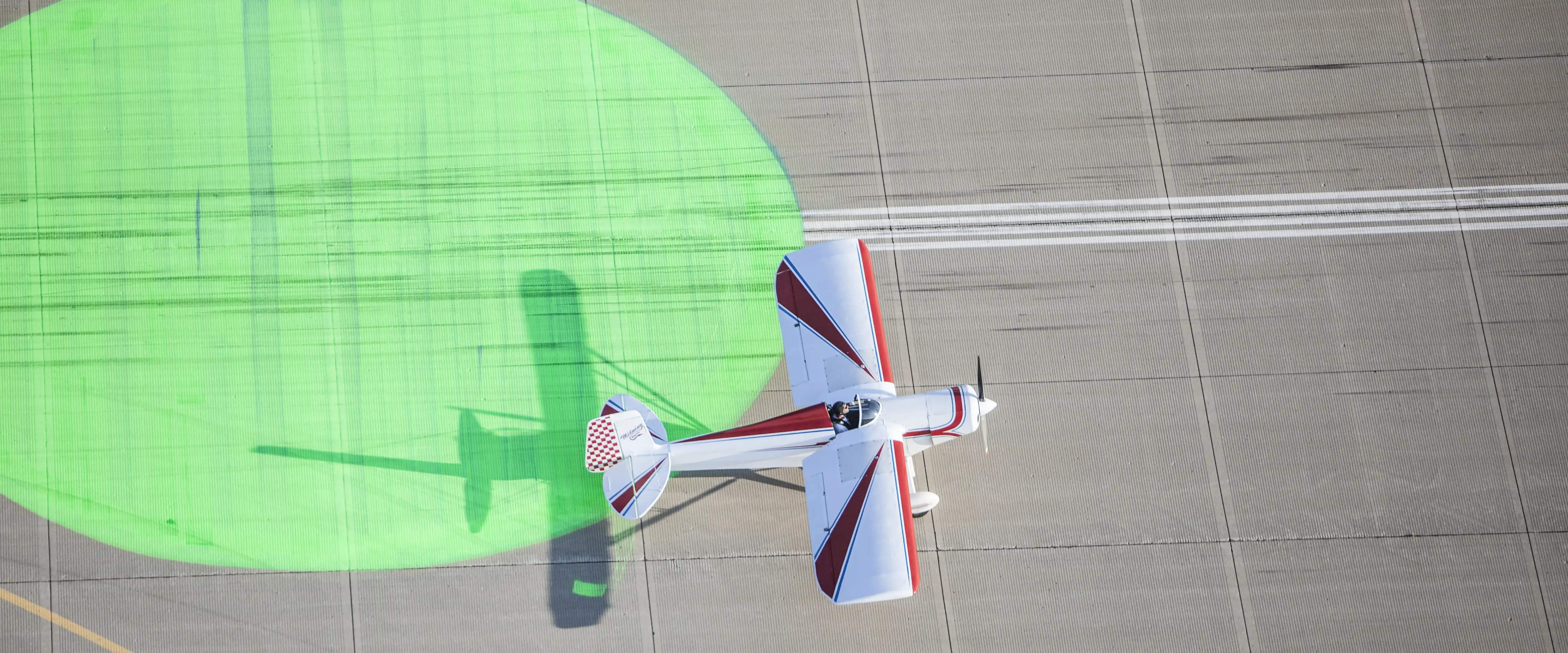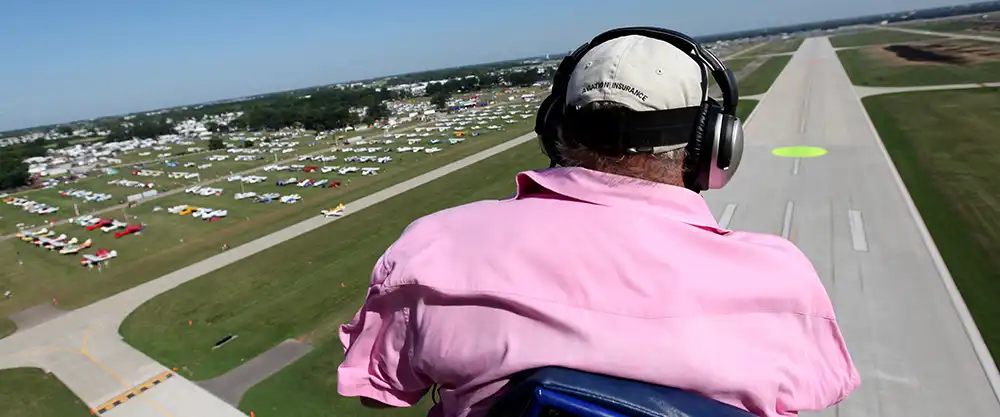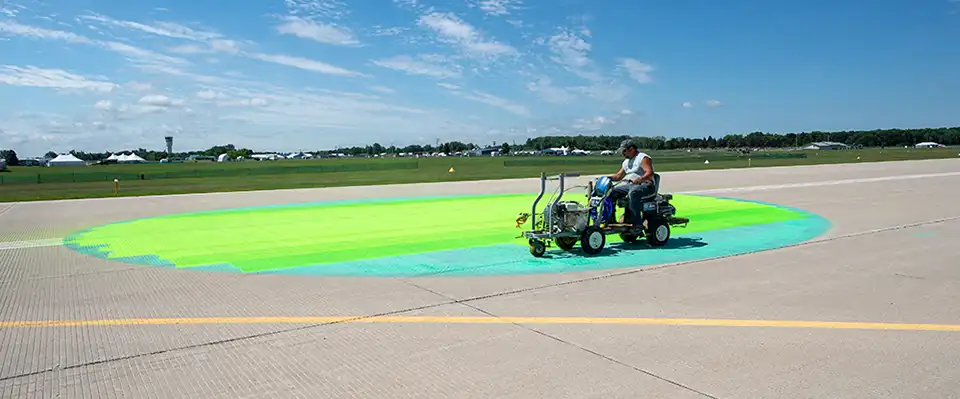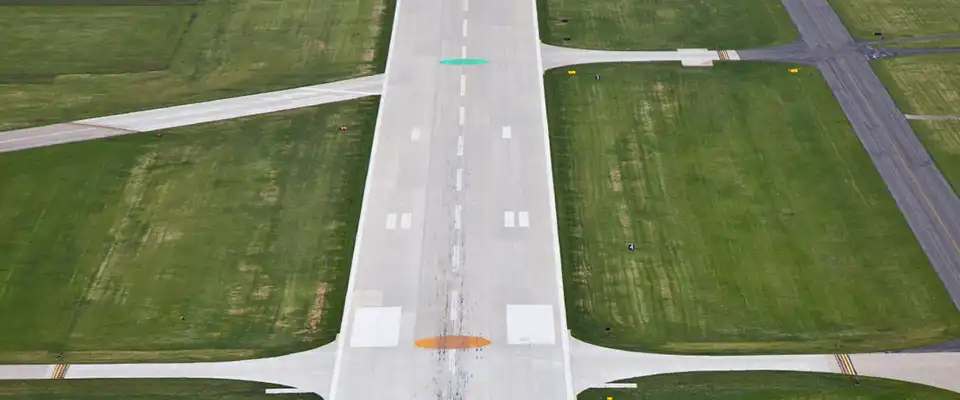The Story Behind the Colored Runway Dots at KOSH
By Megan Esau
July 19, 2018 - Aviation’s family reunion at EAA AirVenture Oshkosh every summer makes the normally quiet Wittman Regional Airport (KOSH) a hub of flying activity. Twenty-seven percent of Wittman’s annual tower operations take place in the 10 days that the AirVenture notice to airmen (NOTAM) is in effect. Even more impressive is that AirVenture boosts KOSH to become the busiest airport in the world during the seven days of the event. By 2017’s numbers, Wittman saw an average of 20 more tower operations per hour than its nearest competitor, Hartsfield-Jackson Atlanta International Airport.
This massive influx of traffic needs to be managed somehow, and Oshkosh does it with approximately 35 gallons of fluorescent Sherwin-Williams paint.
Runways of a Different Color
As part of the annual preparations for AirVenture, during every July since the late 1990s Wittman airport’s maintenance crew has hauled its paint gear out onto the runways to touch up the growing number of large, colorful dots that have become a quintessential part of the experience of flying into EAA’s annual convention.
The first runway markings appeared in 1998, with two designated touchdown points painted on Runway 27.
“In 1999, the original two markings became the orange dot and the green dot,” said longtime EAA volunteer Fred Stadler, who helps coordinate NOTAM preparations with the FAA every year. “A white dot was also added on Runway 9.”
The blue dot became the first to grace Runway 18 Right in 2004. Then in 2005, at the behest of the FAA tower chief, a pink dot was added to that same runway, raising the total count to five.
“In 2008, the purple dot and yellow dot were added to Runway 36 Left, bringing the count of dots to seven and prompting wags to comment about a Wisconsin polka-dot airport,” Fred said.
There are 5 gallons of each color — white, green, and orange for Runway 9/27 and blue, pink, yellow, and purple for Runway 18/36.
Painting the dots is only a one-person job, but it is no quick-and-easy task. Each dot takes approximately 45 minutes to paint, with 15 minutes of cleanup and transition time between each color.
Originally, the dots were painted to be 35 feet wide, but to increase their visibility, the dots are now a whopping 50 feet in diameter, almost double the wingspan of many GA airplanes.
The most recent markings to be added were not dots, but rather a red square and green square on Runway 36 Right, which will stay in use at least through 2018.
Repainting the runways is not the only task busying Wittman’s maintenance crew before AirVenture, though.
Pete Rausch, the airport’s operations manager, said the first phase of preparing the grounds to host more than 10,000 airplanes starts in May, with regularly cutting the airport’s more than 1,000 acres of grass to make sure it stays cropped short.
Many of the larger changes take place when time is down to the wire.
“The airport has to stay functioning as long as it can prior to convention without making the changes, so we really get down a lot of times to the last couple weeks before we start making the changes that occur for the convention,” Pete said.
As AirVenture approaches, Taxiway Alpha becomes Runway 36 Right and 18 Left. Then, all of the signage on the south end of the airport must be switched out to reflect this change.
Double the Fun
Rather than waiting for each incoming aircraft to land and exit the runway one at a time, the dots allow AirVenture traffic controllers to usher in multiple aircraft at once.
The FAA’s rules for standard separation between single-engine aircraft is 3,000 feet, and a single-engine followed by a twin requires 4,500 feet of separation. Wittman’s runway dots are spaced 1,500 feet apart, a distance that was decided upon after careful testing and consideration by the FAA.
“That way, when [the aircraft] are touching down, it’s a visual cue that shows us where our separation is, so we’re not guessing,” said David Kaupp, who for seven years has worked as one of the 64 air traffic controllers it takes to run AirVenture smoothly.
David explained that because of the spacing of the dots, if controllers are landing one single-engine aircraft on the third dot on a runway, they can simultaneously put down a second on the first dot.
On especially traffic-heavy days when both runways are in use, the dots serve as easy-to-spot reference points for pilots in the pattern, providing additional separation between airplanes landing on perpendicular runways such as 36 and 27, for example. “It actually adds a little notoriety to the event, because you’re landing on colored dots and it makes it kind of fun,” David said. “But it’s basically, the colored dots are for high visibility and for us to space our separation that we need to safely do the event.”
Destination: Oshkosh
Landing on the dots at Oshkosh is a rite of passage for many EAA members. The challenge of making a spot landing is not one that many pilots need to perform on an everyday basis. Wittman Regional Airport was the first to paint dots on its runways, and though other airports have adopted the practice for their own large events, landing on the colors is chiefly recognized as part of the Oshkosh experience — an experience that, for some pilots who travel from afar, may be once in a lifetime. It is the ultimate, thrilling signal that you have arrived at the World’s Greatest Aviation Celebration. Welcome to Oshkosh!
This massive influx of traffic needs to be managed somehow, and Oshkosh does it with approximately 35 gallons of fluorescent Sherwin-Williams paint.
Runways of a Different Color
As part of the annual preparations for AirVenture, during every July since the late 1990s Wittman airport’s maintenance crew has hauled its paint gear out onto the runways to touch up the growing number of large, colorful dots that have become a quintessential part of the experience of flying into EAA’s annual convention.
The first runway markings appeared in 1998, with two designated touchdown points painted on Runway 27.
“In 1999, the original two markings became the orange dot and the green dot,” said longtime EAA volunteer Fred Stadler, who helps coordinate NOTAM preparations with the FAA every year. “A white dot was also added on Runway 9.”
The blue dot became the first to grace Runway 18 Right in 2004. Then in 2005, at the behest of the FAA tower chief, a pink dot was added to that same runway, raising the total count to five.
“In 2008, the purple dot and yellow dot were added to Runway 36 Left, bringing the count of dots to seven and prompting wags to comment about a Wisconsin polka-dot airport,” Fred said.
There are 5 gallons of each color — white, green, and orange for Runway 9/27 and blue, pink, yellow, and purple for Runway 18/36.
Painting the dots is only a one-person job, but it is no quick-and-easy task. Each dot takes approximately 45 minutes to paint, with 15 minutes of cleanup and transition time between each color.
Originally, the dots were painted to be 35 feet wide, but to increase their visibility, the dots are now a whopping 50 feet in diameter, almost double the wingspan of many GA airplanes.
The most recent markings to be added were not dots, but rather a red square and green square on Runway 36 Right, which will stay in use at least through 2018.
Repainting the runways is not the only task busying Wittman’s maintenance crew before AirVenture, though.
Pete Rausch, the airport’s operations manager, said the first phase of preparing the grounds to host more than 10,000 airplanes starts in May, with regularly cutting the airport’s more than 1,000 acres of grass to make sure it stays cropped short.
Many of the larger changes take place when time is down to the wire.
“The airport has to stay functioning as long as it can prior to convention without making the changes, so we really get down a lot of times to the last couple weeks before we start making the changes that occur for the convention,” Pete said.
As AirVenture approaches, Taxiway Alpha becomes Runway 36 Right and 18 Left. Then, all of the signage on the south end of the airport must be switched out to reflect this change.
Double the Fun
Rather than waiting for each incoming aircraft to land and exit the runway one at a time, the dots allow AirVenture traffic controllers to usher in multiple aircraft at once.
The FAA’s rules for standard separation between single-engine aircraft is 3,000 feet, and a single-engine followed by a twin requires 4,500 feet of separation. Wittman’s runway dots are spaced 1,500 feet apart, a distance that was decided upon after careful testing and consideration by the FAA.
“That way, when [the aircraft] are touching down, it’s a visual cue that shows us where our separation is, so we’re not guessing,” said David Kaupp, who for seven years has worked as one of the 64 air traffic controllers it takes to run AirVenture smoothly.
David explained that because of the spacing of the dots, if controllers are landing one single-engine aircraft on the third dot on a runway, they can simultaneously put down a second on the first dot.
On especially traffic-heavy days when both runways are in use, the dots serve as easy-to-spot reference points for pilots in the pattern, providing additional separation between airplanes landing on perpendicular runways such as 36 and 27, for example. “It actually adds a little notoriety to the event, because you’re landing on colored dots and it makes it kind of fun,” David said. “But it’s basically, the colored dots are for high visibility and for us to space our separation that we need to safely do the event.”
Destination: Oshkosh
Landing on the dots at Oshkosh is a rite of passage for many EAA members. The challenge of making a spot landing is not one that many pilots need to perform on an everyday basis. Wittman Regional Airport was the first to paint dots on its runways, and though other airports have adopted the practice for their own large events, landing on the colors is chiefly recognized as part of the Oshkosh experience — an experience that, for some pilots who travel from afar, may be once in a lifetime. It is the ultimate, thrilling signal that you have arrived at the World’s Greatest Aviation Celebration. Welcome to Oshkosh!




